Experiments with Memory: Reflections on the 18th Venice Architecture Biennale
Euro-American conceptions of the future often disregard the past—or, worse, reject it. From the Bauhaus to contemporary techno-utopianism, novelty continually underpins the dreams of what could be, particularly those dreams proclaimed by architecture’s loudest voices. The 18th Venice Architecture Biennale—on view through November 26 and featuring a range of work by students, alumni, faculty, and affiliates of the Harvard Graduate School of Design—does not condemn these efforts; rather, the exhibitions and national pavilions imply that such visions are impoverished because they are amnesic. We must not build for tomorrow without understanding and acknowledging all that came before—a position that many less-lauded practitioners globally have long championed.
Memory is one of the strongest, if not often explicitly stated, topics of this Biennale, curated by Ghanian-Scottish architect, academic, and novelist Lesley Lokko. Counterintuitively titled The Laboratory of the Future, the exhibition focuses less on showcasing models of what will be and more on the foundational material and conceptual conditions from which structures arise, from the transnational extraction of minerals on which projects like New York City’s Hudson Yards development depend to a display of the banal correspondence that all building projects and exhibitions such as this require. Process is privileged over product. Totemic structures, which loudly declare singular futures, are replaced by displays of vast archives, such as a collection of every issue of The Funambulist . Studio workshops occupy a cavernous room in the Arsenale as if in situ, messy and overstuffed. These rich displays’ too-muchness suggests multiple paths forward rather than didactic solutions. As a result, the conversations Lokko convenes equalize the exhibition’s participants. In particular, those from Africa and the African diaspora, women, and younger practitioners are treated as prominently as those architects whose names typically dominate the most prestigious architecture competitions, festivals, and building contracts.
Many projects highlight instances of success without singular architects. The Ecuador-based design agency Estudio A0, whose co-principal Ana María Durán Calisto (Loeb Fellow ’11) has served as Design Critic in Urban Planning and Design at the GSD, challenge colonial narratives of “primitive” Amazonian cities in Surfacing–The Civilized Agroecological Forests of Amazonia . Light Detection and Ranging (LiDAR) technology used for gold prospecting helped produce maps of 26 ancient urban areas, which featured waterways, suburbs, and other complex structures.
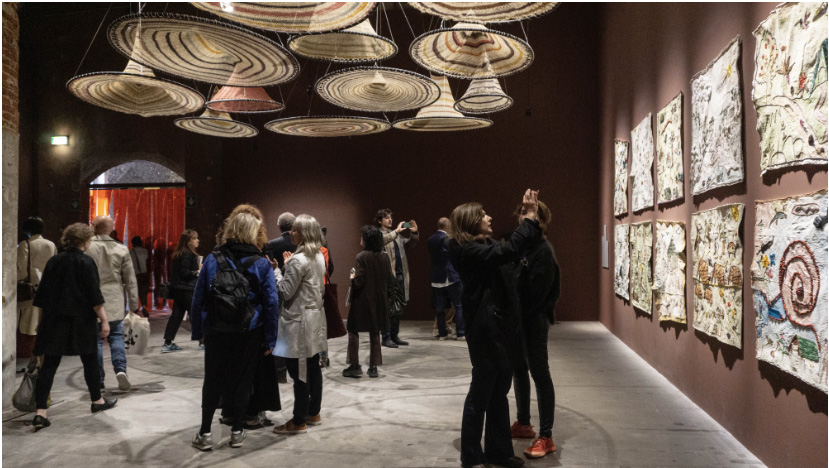
These discoveries reject notions that the forest was entirely “wild” and indicate that inhabitants of the Amazon River basin had both advanced understandings of their natural surroundings and the ability to shape them. Woven tapestries (a recurring mode of expression throughout the Biennale) depict imagined representations of life and the built environment in these cities, which in turn make material the interlocking nature of the urban and ecological.
The earth again acts as a depository of novel notions of the city in The Nebelivka Hypothesis, presented by David Wengrow and Eyal Weizman with Forensic Architecture and the Nebelivka Project. Eleven settlements from 6000 years ago, each with domestic buildings built in a ring encompassing a vast open area, were discovered in central Ukraine using modern archaeological technology. What the curators describe as the “centerless” configuration of Nebelivka is not just a banal characteristic. “No evidence of palaces, central storage, administration, rich burials, nor any other signs of top-down control” were found in excavations, the presentation details—a discovery that contradicts the early scholarly consensus that cities require “hierarchical form and structure.” Additional evidence was found that inhabitants’ farming had a gentle relationship with the surrounding land. This relates to the area’s chernozem, a remarkably rich soil, which the researchers argue may not have arisen by chance. It may be anthrosol—soil formed through human activity—which could demonstrate that cities can not only sustain but improve ecological health.
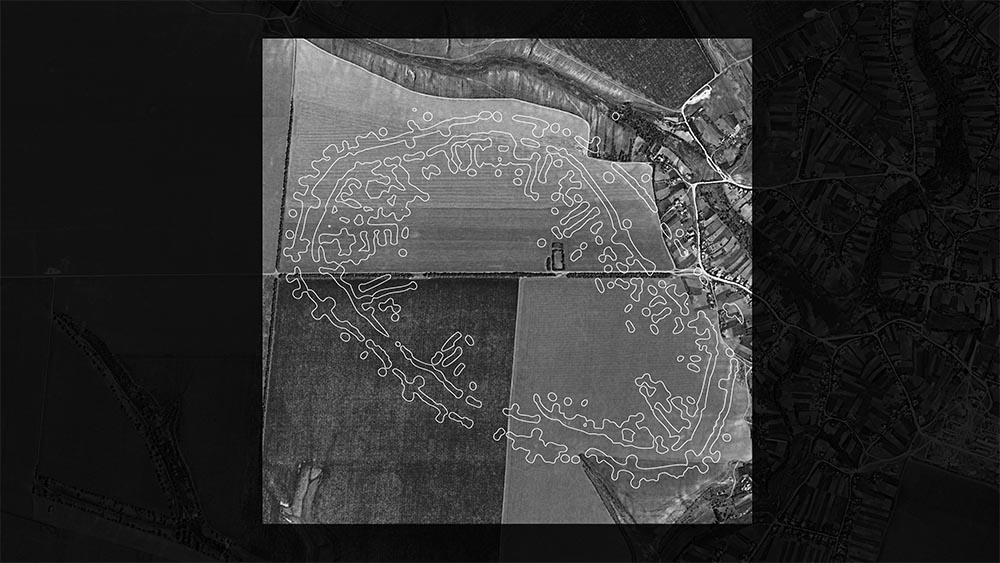
High-tech research is not required in order to learn from the past, though. The Slovenia Pavilion’s exhibition, +/-1 °C: In Search of Well-Tempered Architecture, goes so far as to criticize high-tech intervention in solving ecological concerns. Rather than dismiss vernacular buildings as charming ethnographic curiosities, curators Jure Grohar, Eva Gusel, Maša Mertelj, Anja Vidic, and Matic Vrabič showcase dozens of traditional buildings that are remarkably energy efficient architecturally, without requiring complex engineering solutions hidden behind walls. The exhibition implies that learning from these structures is not an issue of embracing nostalgia but rather common sense, as myriad solutions to regulating building temperatures already exist: the central stove that dried clothes, cooked food, and served as a gathering space for sleep and sociality in Slovenian homes; micro-sleeping cells in German cottages that could be closed and heated by an individual’s own body heat; a smaller room for social activities within Slovenian huts that could be heated separately from the pantry and the other less-used spaces surrounding it.
Edgar’s Sheds, an installation by GSD Assistant Professor of Architecture Sean Canty and his firm, Studio Sean Canty, also celebrates the vernacular. It features a fragmentary and poetic reconstruction of two sheds built by his great-grandfather Edgar in Eliott, South Carolina, enacting what Canty calls “retroactive reproduction.” The partial buildings “draw attention to the holes and ruptures of our collective history of black experience,” he writes, which is “a direct consequence of slavery.”
In each of these examples, and throughout much of the Biennale, the definition of “architect” is challenged. There is no single mind to whose genius these vernacular innovations can be attributed, for example.
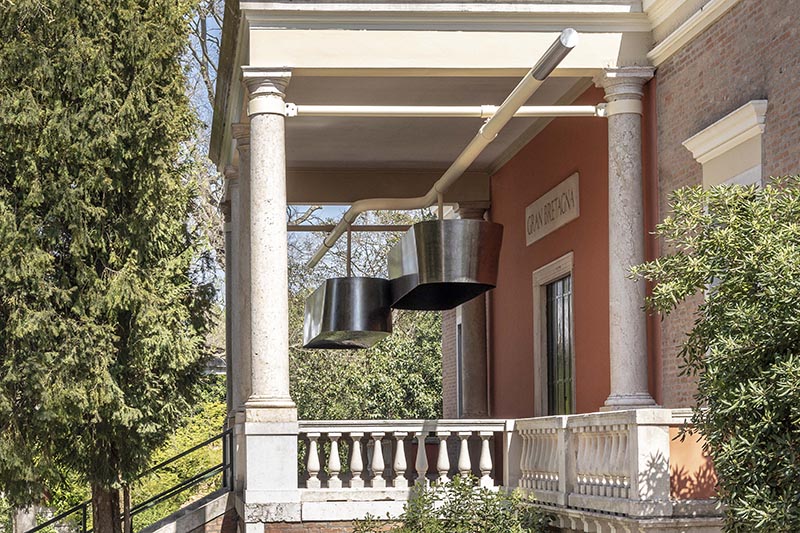
Recognition instead must go to collective memory, which the Great Britain Pavilion designates a space maker in its own right. Curated by Joseph Zeal-Henry (LF ’24), Jayden Ali, Meneesha Kellay, and Sumitra Upham, Dancing Before the Moon argues that ritual practices, which depend on sustained and embodied collective memory, act as “spatial portals.” The artworks on display address hybrid identities in their reflections on rituals both ancestral and contemporary. Monumental vessels by Jayden Ali evoke Cypriot cuisine and Trinidadian steel-pan bands. Mac Collins’s abstract sculpture made of ebonized ash timber, at once anthropomorphic and otherworldly, celebrates the dominoes popular amongst British Jamaicans.
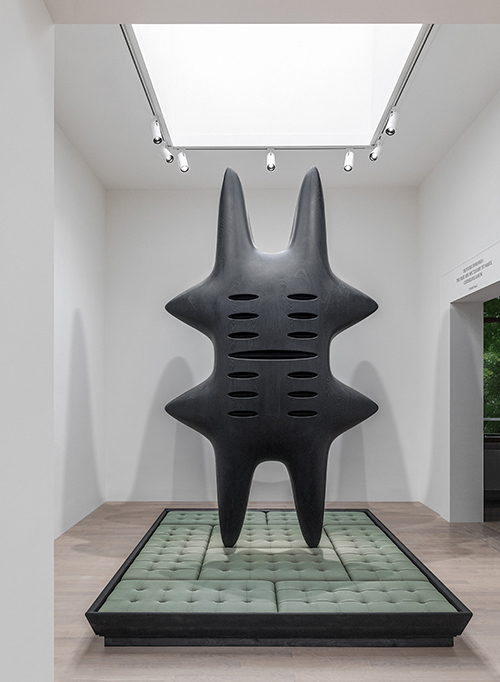
For diaspora communities especially, cooking, music, games, and similar actives help dissolve distance and time, bridging international borders psychically and collapsing temporalities. “They rethink the past and imagine alternative futures where architecture is agile and spontaneous and communities are bound together by social (rather than economic) practices,” the curators assert in their introduction. To dismiss these ritual participants as non-architects is in turn to delimit the possibilities of how space is understood and who has the authority to claim as well as design for it.
In striving to define new futures, the Biennale foregrounds a history in which too many voices have been dismissed and too many details about both the births and deaths of built spaces have been cast aside. Even the awards at the Bienniale sought to address this past occlusion, including Nigerian architect Demas Nwoko’s Golden Lion for Lifetime Achievement. Despite designing “forerunners of the sustainable, resource-mindful and culturally authentic forms of expression now sweeping across the African continent—and the globe,” Lokko writes, Nwoko remains “largely unknown, even at home.”
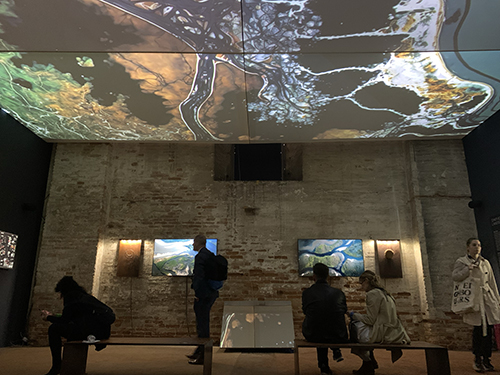
The casting aside of whole populations is reflected in Synthetic Landscapes, a project by Stephanie Hankey, Michael Uwemedimo and Jordan Weber (all Loeb Fellows ’22) that details the violent extraction of oil near the Niger Delta. Chevron and other oil companies’ interventions in Nigeria have forever changed the local ecosystem, destroying villages as well as the natural environment. The carbonized soil that resulted from this ecological violence “cannot be remediated, only removed, contained, moved and moved again,” writes the team, who illustrate this by using this soil itself in the exhibition’s floor. The act is a physical reminder of a warning from Amitav Ghosh about how we consider the past, which the trio quotes: “Those at the margins are now the first to experience the future that awaits all of us.”
The need to acknowledge those too-long disregarded is also poignantly addressed in unknown, unknown, an installation by Eric Howëler (Associate Professor in Architecture at the GSD), Mabel O. Wilson, and J. Meejin Yoon (MAUD ’97). The multifaceted immersive work arises from Höweler+Yoon’s Memorial to Enslaved Laborers at the University of Virginia, which opened in 2020. It commemorates the approximately 4000 enslaved peoples on whose labor the university was dependent from 1817 to 1865. Rather than honor the dead in stereotypical monumental forms such as sculptures, the work makes visible these men and women’s erasure and their lack of recorded identities. Videos illustrate the scale of this violence by depicting a list of their limited descriptors, recorded in ledgers and similar archival materials, such as “Peter, Unknown,” “Runaway, Unknown,” and “Unknown, Unknown.” This is in turn accompanied by a recitation of these “names,” read in part by three of their descendants. The exhibition is made even more haptic by the projection surfaces themselves: muslin sheets hanging from the ceiling, which specifically reference the cotton-centric labor forced upon this enslaved population.
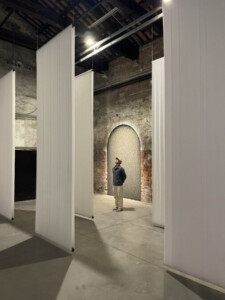
As these and the majority of the projects on display in Venice emphasize, the question of the future must not remain the restricted domain of only a few architects’ fantastical speculations. Rather than provide solutions, this Biennale instead strives to engrain a basic understanding of how to answer the question at all. It does not ask us to stop dreaming. It merely proposes that in order for dreaming to succeed, we must first understand who designs, who builds, and how the materials they use affect us all.
Kongjian Yu Wins 2023 Cornelia Hahn Oberlander International Landscape Architecture Prize
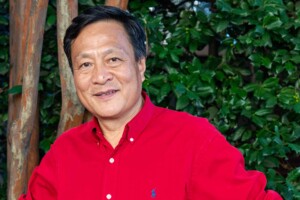
The Cultural Landscape Foundation (TCLF) has named Beijing-based landscape architect Kongjian Yu (DDes ’95) the winner of the 2023 Cornelia Hahn Oberlander International Landscape Architecture Prize , a biennial honor that includes a $100,000 award and two years of public engagement activities focused on the laureate’s work and landscape architecture more broadly.
Yu recently delivered the Sylvester Baxter Lecture at the Graduate School of Design (GSD), “Adaption: Political, Cultural, and Ecological Design—My Journey to Heal the Planet.” His guiding design principles are the appreciation of the ordinary and a deep embrace of nature—even of its potentially destructive aspects, such as flooding. Yu’s thinking about “ecological security patterns” helped shape environmental protection efforts throughout China. And his promotion of the “sponge city” concept, which uses landscape to capture, filter, and store rainfall for future use and reduce flood risks, helped to spur the Chinese government to launch an ambitious sponge city campaign across the country and has gained global attention.
Named in honor of the late landscape architect Cornelia Hahn Oberlander (BLA ’47), the Prize awarded by the TCLF is bestowed on a recipient who is “exceptionally talented, creative, courageous, and visionary” and has “a significant body of built work that exemplifies the art of landscape architecture.”
The international, seven-person Oberlander Prize Jury selected Yu from among more than 300 nominations from across the world. In naming the 2023 winner, the Oberlander Prize Jury Citation noted of Yu, he is a “brilliant and prolific designer … [who] is also a force for progressive change in landscape architecture around the world.”
“He lives and breathes his conviction that landscape architecture is the discipline to lead effective responses to the climate crisis,” said TCLF President & CEO Charles A. Birnbaum.
Gary R. Hilderbrand, Peter Louis Hornbeck Professor in Practice of Landscape Architecture and Chair of the Department of Landscape Architecture at the GSD, adds that Yu is the “all-time greatest spokesperson for landscape architecture in China—a nation that needs environmental rescue on a colossal scale.”

Yu is Professor and founding dean of Peking University College of Architecture and Landscape, and founder and design principal of Turenscape . His projects have won numerous international design awards, including 14 ASLA Excellence and Honor Awards and seven WAF Best Landscape Architecture of the Year Award. Yu is also the author of over 20 books and more than 300 papers and is the founder and chief editor of the internationally awarded magazine Landscape Architecture Frontiers. Yu was elected International Honorary Member of the American Academy of Arts and Sciences in 2016 and received the IFLA’s highest honor, the Sir Geoffrey Jellicoe Award, in 2020, which celebrates a living landscape architect whose “achievements and contributions have had a unique and lasting impact on the welfare of society.”
The Cultural Landscape Foundation, founded in 1998, is a 501(c)(3) non-profit founded in 1998 to connect people to places. TCLF educates and engages the public to make our shared landscape heritage more visible, identify its value, and empower its stewards. Through its website, publishing, lectures, and other events, TCLF broadens support and understanding for cultural landscapes.
Black in Design 2023 Creates a “Home Away From Home” at the GSD
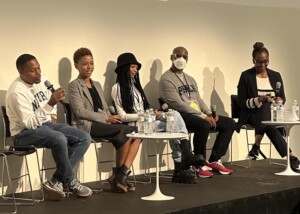
Where is home for you? It’s an ice-breaker question we all get asked at some point, especially at the start of a new academic year. For many it’s a city, a street, a building, or a community. For attendees at this year’s Black in Design conference (BiD), held at the Graduate School of Design from September 22nd through the 24th, answers ranged from Chicago to Nigeria. But home could also be much closer and subtler; for many attendees, home could be evoked by the familiar bottles of Nivea shea lotion the conference organizers added to the GSD’s main floor restrooms.
The African diaspora remains critically underrepresented in traditional design fields such as architecture, landscape design, and urban planning. Since its inaugural session in 2015, the Black in Design conference has worked to create a space where Black designers from all fields, beyond credentialed architects—from visual artists to DJs to family archivists—feel welcome and celebrated.
“I think we all came into the planning process knowing that it was important to reflect on the precedents that we use in our work, and a lot of that was not design-based,” said Kai Walcott (MLA I ’24), one of the conference co-chairs. She noted that despite having professional training in design, a lot of what she draws on to inform her own work and thesis research comes from Black visual and performing arts from outside the academy. Those disciplines, Walcott said, “reflected more of the ideas that I want to… grapple with to understand how Black people use space and make space.” These sources and ways of creating and preserving knowledge are often missing from traditional design curricula, the conference organizers noted, and they sought to develop conference themes that would make practitioners from a wide range of formal and informal disciplines feel comfortable alongside each other.
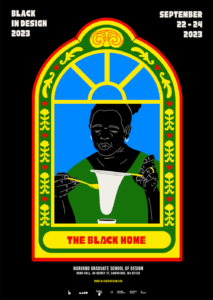
This year’s theme, the Black Home, came out of listening sessions held between the organizing committee members (current GSD students Dora Mugerwa [MLA I ’24]; and Walcott; and recent alumni Tobi Fagbule [MDes ’23] and Michael Johnson, [MUP ’23]); representatives of Africa GSD; the GSD African American Student Union; and Black GSD students generally, who were asked what topics they wanted to see represented. These sessions revealed a number of themes that ultimately coalesced around the idea of home not just as a building to be designed, but as a synthesis of objects, scents, colors, or feelings. Taken together, these are elements that can make an experience of home simultaneously unique and a source of commonality across a diaspora.
When it came time to choose keynote and panel speakers, Mugerwa said it was important that there was a mix of invitees from both inside and outside the boundaries of what is traditionally considered “design” in the professional field. “We wanted to focus on folks whose work was new to us,” she said, “and show how artists and designers can take inspiration from people outside of the discipline. But we tried to have a balance of design practitioners and non-practitioners as well that could have cross-disciplinary conversations.”
In addition to coming from diverse professional and curatorial backgrounds, the conference organizers invited speakers who also had different visions of what home meant to them. In the keynote panel, “Legacy: Defining the Black Home (Past, Present, Future),” the first question asked by moderator Toni L. Griffin, a Professor in Practice at the GSD and Founder of urbanAC, was: Can home be designed? Panelist Bryan Mason, Co-Founder and Creative Director of AphroChic , responded that like everything in our daily lives, a home and the objects within it can be designed, and that Black people have been doing so for centuries. In contrast, panelist Germain Barnes (the Principal of Studio Barnes , and Associate Professor and Director of the Master of Architecture Graduate Program at the University of Miami School of Architecture) was more skeptical, noting that designers could facilitate other people’s ability to create home, but that for him home ultimately came down to people, feelings, and sensory experiences that cannot be explicitly designed. Renata Cherlise, Founder of the Black Archives multimedia platform and author of Black Archives: A Photographic Celebration of Black Life (2023), drew from memories and how they imbue art, objects, and spaces. “I know Great Grandma’s house is not there but I still go back in my dreams,” she said, noting that her recent book celebrates memories and sensory experiences of place through photographs in Black family archives.
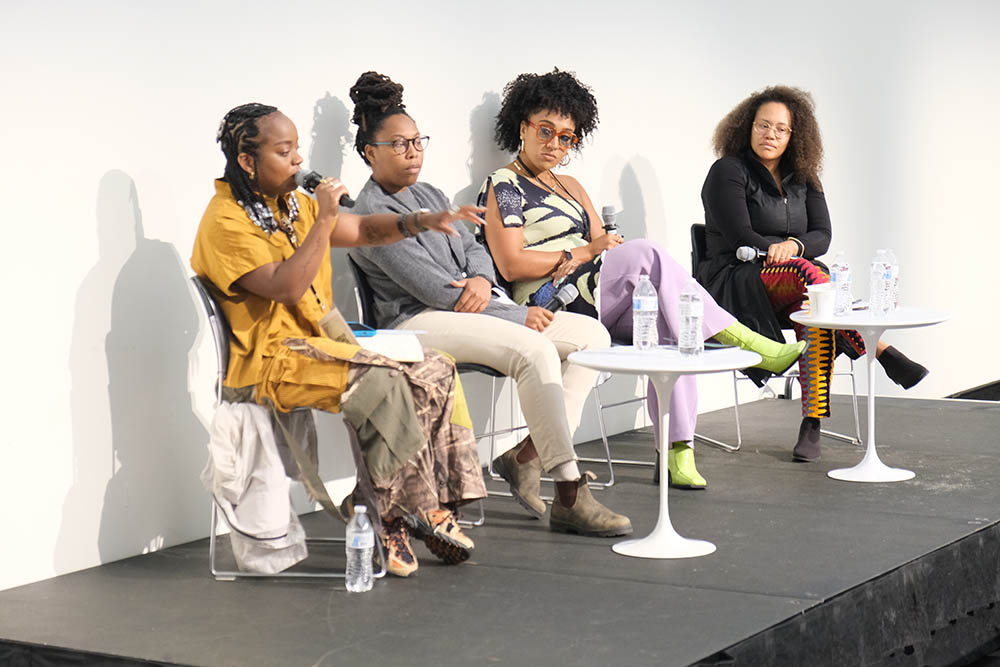
In addition to panels, Black in Design conferences feature hands-on workshops hosted throughout the weekend. This year’s workshops included “Black Feminist Imagination and the Black Home,” led by BlackSpace Urbanist Collective , and “Archiving the Black Home,” led by Wayside studio Founder, public artist, and educator Curry J. Hackett. The sessions gave conference participants a way to not only form cross-disciplinary connections with each other, but to approach their own design practice through potentially new methods such as incorporating artificial intelligence or curating multimedia archival exhibitions.
In searching for workshop leaders, Walcott said, “We wanted people who were doing this work but may not (yet) have the platform of Harvard, to try and connect them,” with the GSD community and a broader design audience.
Between workshops, panels, and food catered by the local restaurant Jamaica Mi Hungry , the conference organizers wanted to ensure the GSD felt like home as well, hence the bottles of lotion in the bathrooms—an immediate hit with attendees. Nina Cooke John, a keynote panelist and Founding Principal of Studio Cooke John Architecture and Design , noted that while she has created architectures of home, recently through Obsidian House , home is also found in gestures of care just like that.
While BiD is a temporary experience, one piece of it remains in Gund Hall in the form of an exhibition called Stories That Take Me Home, on view until October 18th. Curated by the conference co-chairs and designed by Àrà Lab, a project of Fagbule and Sumayyah Súnmàdé Raji (MArch ’23), the exhibition seeks to reclaim images and theorizations of the Black Home in Africa from negative associations with conflict or destitution, or “as mere artifacts, objects for study, or curiosities to be sampled,” according to the curators’ statement. Instead, the exhibit demonstrates “their profound multidimensionality… (reflecting) culture, identity, and traditions and generate(s) spaces of the home that transcend the physical realm.”
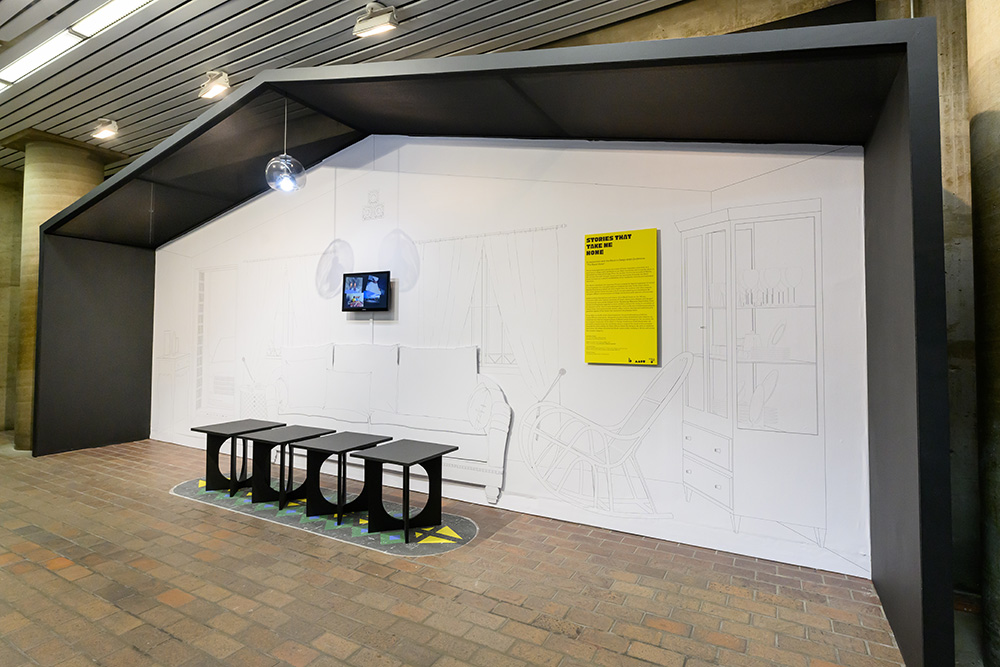
Visually, the exhibition is anchored by an outline drawing of a home with an arch and porch yard. “That was something that was very close to our hearts,” Fagbule said. She grew up in Nigeria and said her context for home is always changing, but that there are elements of home that start to appear in different ways throughout her daily life wherever she happens to be living. She wanted viewers to share in that and recall their own stories of home, or treasured objects, over time.
One of the things that made Black in Design successful, Mugerwa added, is the feeling of commonality it fostered. While people may think their home or neighborhood is unique, they could come to this exhibition, and the various conference events, and recognize a sofa, a cabinet in the front room that they were never allowed to touch as a child, a glass figurine, a familiar brand of lotion, and so on. “So we wanted to reinforce that multiplicity, that we are not a monolith,” she said, “but it was nice to see those moments where there was overlap, where we could all identify with something similar.”
Morgan Forde is a third-year doctoral student at the Harvard University Graduate School of Design where her work focuses on the intersections of twentieth-century US urban planning history and the socio-spatial activism of radical Black Power, socialist, and feminist movements. She has been a freelance journalist and editor for several years, and her work has appeared in the Los Angeles Review of Books, Mic, The Nation, Ploughshares, Popular Mechanics Magazine, and elsewhere.
Remembering Claude Cormier (1960–2023)
I first met Claude Cormier (MDes ’94) when he approached me about being a teaching assistant position in my core studio course, in 1993. What impressed me most in our first meeting: his excitable voice, with an upward-sounding pitch, along with his genial and upbeat manner, which made me feel like I already knew this man. A quick wit, a quizzical intensity. I liked this about him. This was the convivial and always curious guy with whom I enjoyed a warm friendship over the past 30 years.
Claude passed away on September 15 this year, at age 63, after a four-year fight with a rare and uncurable form of cancer. His was a life too short, though it was filled with great drive and remarkable success. Claude was a rare landscape architect whose take on common design problems was nothing if not uncommon.
I will admit that fun has perhaps only rarely been a design motivation for me, but it was almost always this way for Claude. Once he established his firm in Montreal, he immediately made his mark with projects that came to him in the form of the typical kinds of urban problems we face everywhere—but his design solutions always defied expectations, and he was persuasive with concepts that were at times far-reaching though always precise in execution. Painted or wrapped trees, blue sticks, balls and cones, pink lights, umbrellas, fake stones—often ordinary things made dramatically unordinary. His admiration for and friendship with Martha Schwartz surely influenced this way of working, but Claude made it his own. He rather famously used to say he imagined himself as the love child of Martha Schwartz and Frederick Law Olmsted—another of his great influences, and a very different one at that.
Because of the sustained popular appeal of Claude’s work, he accumulated attention, enthusiasm, and recognition from far beyond the design community—including being appointed a knight of the Ordre National du Québec. But while he enjoyed peer recognition much like the rest of us, these things had little effect on Claude’s persona or his ego. What animated him the most was talking about the work, along with the jubilant embrace of his work by those who use the public realm spaces he and his partners and staff designed. Those of us who knew him will remember his love of fashion and design, his uncanny passion for art—high, low, fake, or real—and his unbending joyfulness in life. Amen. Yet his far larger legacy will remain those life experiences by the citizens who inhabit his comic, playful, and highly intelligent parks and squares every day.
A comprehensive account of Cormier’s life and career was written by Beth Kapusta and can be found at The Cultural Landscape Foundation’s website .
Curry J. Hackett and Gabriel Jean-Paul Soomar Win the Radcliffe Institute Public Art Competition
Harvard Radcliffe Institute recently announced Curry J. Hackett (MAUD ’24) and Gabriel Jean-Paul Soomar (MArch II/MDes ’24) winners of the biennial Radcliffe Institute Public Art Competition . The duo won for their innovative proposal titled HOLD, a 30-foot-long U-shaped enclosure designed to symbolize the spaces Black communities construct for themselves, nodding to the screened porches of the American South while acknowledging the cargo holds of slave ships. The artwork is expected to be unveiled at the Susan S. and Kenneth L. Wallach Garden on Brattle Street in May 2024.
The competition offers Harvard students an opportunity to showcase projects at the intersection of art, landscape design, and structural architecture. Participants compete for a prize that includes funding for the construction of the artwork and mentorship throughout the development and installation process.
HOLD is designed to be “an outdoor experience that acknowledges and celebrates the complicated relationship Black folks maintain with enclosure,” the artists said in a statement . The structure will serve as a reminder of the various ways in which Black mobility has been restricted (redlining, incarceration, slavery) while also calling to mind the spaces Black communities build for themselves (the Black church, the front porch, the hair salon)—spaces which signify safety and embrace. Hackett and Soomar intend for HOLD to be a gathering place for events and classes—a place “for Black students and underrepresented students across campus to find space and create space for themselves.”
This public art installation is the first for Soomar and the fourth for Hackett, although Soomar has seen his work exhibited at such notable institutions as New York’s Museum of Modern Art (MoMA) and the Venice Biennale Architettura 2023. Hackett was also a shortlist candidate for the 2022 Wheelwright Prize.
The Radcliffe Institute for Advanced Study at Harvard University—also known as Harvard Radcliffe Institute—is one of the world’s leading centers for interdisciplinary exploration. We bring students, scholars, artists, and practitioners together to pursue curiosity-driven research, expand human understanding, and grapple with questions that demand insight from across disciplines. For more information, visit www.radcliffe.harvard.edu .
Adam Longenbach Receives 2023 Carter Manny Award Citation of Special Recognition
Adam Longenbach, a doctoral candidate in Architecture, Landscape Architecture, and Urban Planning, was recently honored with a Carter Manny Award citation of special recognition from the Graham Foundation . He is also a 2023–2024 Graduate Fellow in Ethics at the Edmond and Lily Safra Center for Ethics and a 2023 Harvard Horizons Scholar.
Established in 1996, the Carter Manny Award program supports the completion of outstanding doctoral dissertations on architecture and its role in the arts, culture, and society. The only pre-doctoral award dedicated exclusively to architectural scholarship, it recognizes emerging scholars whose work promises to challenge and reshape contemporary discourse and impact the field at large.
In his dissertation “Stagecraft / Warcraft: The Rise of the Military Mock Village in the American West, 1942–1953,” Longenbach investigates the mid-twentieth-century entanglement of wartime policies, government agencies, private sector collaborations, and mass media technologies that led to the rise of military “mock villages.” His work connects this history to the ongoing production and operation of mock villages by militaries and police forces around the world, questioning what it means to replicate the built environment for the purpose of enacting violence in and against it.
Before coming to Harvard, Longenbach practiced for nearly a decade in several design offices, including Olson Kundig Architects, Allied Works Architecture, and Snøhetta, where he was the director of post-occupancy research. His writing can be found in Thresholds, The Avery Review, and Log, among others.
Martin Bechthold, Holly Samuelson, and Amy Whitesides Receive Project Funding from the Salata Institute Seed Grant Program
The GSD’s Martin Bechthold, Holly Samuelson, and Amy Whitesides are among the grant recipients of the first Salata Institute Seed Grant Program, launched in April to enable new interdisciplinary research in climate and sustainability. The program will support 19 faculty members working across seven Harvard Schools with funding for projects ranging from exploring a new, algae-based building insulation material to researching the carbon footprint of AI-driven computing.
Martin Bechthold, Kumagai Professor of Architectural Technology and Co-Director of the Doctor in Design Studies Program, is co-principal investigator on a project with Jennifer Lewis of the John A. Paulson School of Engineering and Applied Sciences. The team will research and develop a proof of concept for a carbon-negative insulation material made from microalgae, a cost-effective way to reduce buildings’ energy consumption and emissions.
Holly Samuelson, Associate Professor of Architecture, is the principal investigator on a project researching how architects can prioritize saving heating or cooling energy by analyzing the potential benefits of revising glass requirements. The optimal glass properties depend on not only building type and window orientation—variables already lumped together in today’s broad-brush building codes—but also properties of evolving heating systems and electricity generation.
Amy Whitesides, Design Critic in Landscape Architecture, is the principal investigator studying how forests play a crucial role in mitigating climate change. Agroforestry may offer means to diversify and protect lands that face encroachment and climate threats and often support lower-income communities. In support of the project, Whitesides will bring together landscape architects, planners, foresters, farmers, municipalities, and land management specialists.
Announcing the Harvard GSD Fall 2023 Public Program
The Harvard Graduate School of Design (GSD) announces its Fall 2023 schedule of public programs and exhibitions. Many of the season’s initiatives reflect on the relationship between design and the public good. Pritzker Architecture Prize recipient Shigeru Ban will present a lecture on balancing architectural practice and social engagement (September 19). Angela D. Brooks, housing justice advocate and president of the American Planning Association, will deliver the Rachel Dorothy Tanur Memorial Lecture (November 1). Featuring keynote speakers Germane Barnes, Renata Cherlise, Nina Cooke John, and Bryan Mason, the fifth biannual Black in Design conference (September 22–24), explores the multidimensionality of “The Black Home.” Rethinking the space of law and punishment is the focus of the Carceral Landscapes symposium (October 12–13), co-organized by the GSD and the Institute to End Mass Incarceration at Harvard Law School.
The program launches on September 12 with a release event for Harvard Design Magazine #51: “Multihyphenate,” featuring guest editors Sean Canty, Assistant Professor of Architecture, and John May, Associate Professor of Architecture, both from the GSD, and Zeina Koreitem, design faculty at the Southern California Institute of Architecture (SCI-Arc). The associated exhibition Multihyphenation will be on display at the Druker Design Gallery August 30 through October 9, 2023.
The climate emergency provides an urgent touchstone for other programs, including the exhibition Our Artificial Nature: Perspectives on Design for an Era of Environmental Change (opening October 26). The presentation will spotlight research conducted at the Harvard Center for Green Buildings and Cities . In tandem with the exhibition, the GSD will host Carson Chan, curator at the Museum of Modern Art in New York, who will engage GSD faculty in a conversation about past design speculations, current research, and practice. Kongjian Yu, Professor and Dean, College of Architecture and Landscape Architecture, Peking University, will lecture on ecological urbanism (September 14), and Tomás Folch, Design Critic in Landscape Architecture at the GSD, will discuss water in Andean cities (November 3).
The complete public program calendar appears below and can be viewed on Harvard GSD’s events calendar. Please visit Harvard GSD’s home page to sign up to receive periodic emails about the School’s public programs, exhibitions, and other news.
Fall 2023 Public Program
Multihyphenation
Exhibition associated with Harvard Design Magazine #51: “Multihyphenate”
Druker Design Gallery
August 30–October 9
Harvard Design Magazine #51: “Multihyphenate,” issue launch with editors Sean Canty, Zeina Koreitem, and John May
Frances Loeb Library
September 12, 12:30pm
Kongjian Yu
Sylvester Baxter Lecture
September 14, 6:30pm
Shigeru Ban, “Balancing Architectural Works and Public Contributions”
September 19, 6:30pm
Black in Design 2023: The Black Home
September 22–24
Tickets available through the conference website
Irma Boom and Remment Koolhaas, “Bookmaking”
September 27, 6:30pm
Michele De Lucchi, “Earth Stations: Future Sharing Architecture”
September 28, 6:30pm
Anita Berrizbeitia, “The Blue Hills: Charles Eliot’s Design Experiment (1893–1897)”
Frederick Law Olmsted Lecture
October 10, 6:30pm
Carceral Landscapes
Symposium
October 12–13
This event is co-organized by the GSD and the Institute to End Mass Incarceration at Harvard Law School
David Gissen in conversation with Sara Hendren
Loeb Lecture
October 17, 6:30pm
Manuel Salgado, “City Making”
Jaqueline Tyrwhitt Urban Design Lecture
October 24, 6:30pm
Our Artificial Nature: Perspectives on Design for an Era of Environmental Change
Exhibition
Druker Design Gallery
October 26–December 21
Angela D. Brooks
Rachel Dorothy Tanur Memorial Lecture
November 1, 6:30pm
Tomás Folch, “Hydraulic Geographies: Atlas of the Urban Water in the Andean Region”
Kiley Fellow Lecture, Room 112 Stubbins
November 3, 12:30pm
Lina Ghotmeh, “Living in Symbiosis–an Archeology of the Future”
November 6, 6:30pm
Pier Vittorio Aureli, “The Longhouse”
November 9, 6:30pm
Catherine Mosbach, “Design is a Language being Receptive being in Motion”
Aga Khan Program Lecture
November 14, 6:30pm
Opening of Our Artificial Nature: Perspectives on Design for an Era of Environmental Change
Thursday, November 16, 6:30pm
Conversation co-organized by the GSD and the Harvard Center for Green Buildings and Cities and moderated by Carson Chan, Director, Emilio Ambasz Institute for the Joint Study of the Built and Natural Environment, MoMA
All programs take place in Piper Auditorium, are open to the public, and will be simultaneously streamed to the GSD’s website, unless otherwise noted.
Registration is not required, unless otherwise noted. Please see individual event pages for full details and the most up-to-date information.
The Design Thinking Behind the GSD’s New Identity
A Language and a Tool
A visual identity is both a language and a tool. The Harvard Graduate School of Design needed an updated language of forms to communicate the School’s mission and values, as well as a tool to facilitate its pedagogical activities and day-to-day operations with a common set of visual standards.
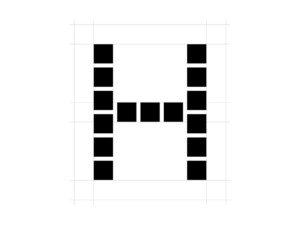
Dean Sarah M. Whiting, in welcoming the GSD community back last year as Covid-19 pandemic restrictions eased, described the School as a place that synthesizes different and sometimes competing frameworks of knowledge. She challenged GSD students, faculty, staff, and affiliates to drive a public dialogue, bringing the knowledge produced at the School to the world.
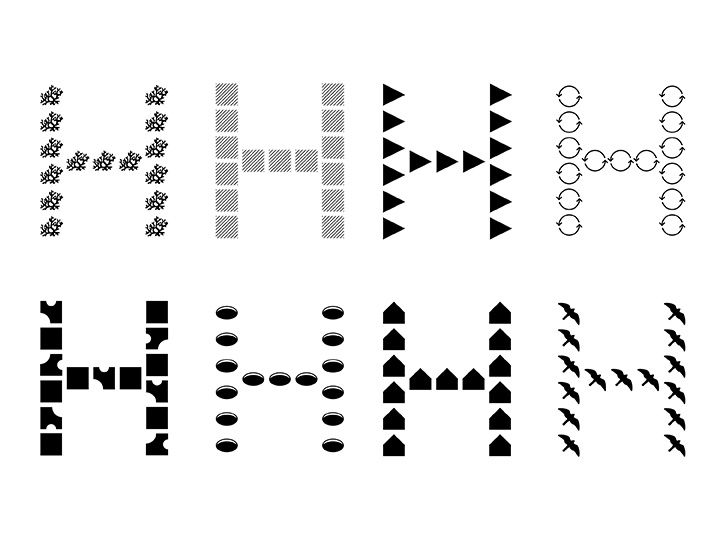
Conceived this way, the GSD is a dynamic center for learning and discourse. An identity that can help galvanize the breadth of the GSD community and convey the diversity of its ideas must be both adaptable and resilient. It needs to be functional, able to work with everything from large-scale physical signage to social media posts. In every context, the identity has to embody the critical design thinking at the heart of the School.
The University
The GSD is rooted in the broader Harvard University community. Early versions of the School’s identity took the Harvard shield as a point of departure. Right at the turn of the 21st century, the GSD departed from this tradition—and set itself apart from other Harvard schools—by adopting the “Flying H”, designed by Nigel Smith.
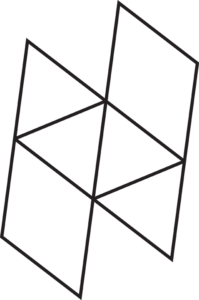
The abstracted Harvard “H” projects the dynamic outlook of an educational institution devoted to fostering leaders in design, research, and scholarship.
The School
The heart of the GSD is our main building, Gund Hall. This is where the energy associated with learning, teaching, and study is most palpable. In turn, the Trays are at the heart of Gund. This iconic space facilitates the work that happens here.
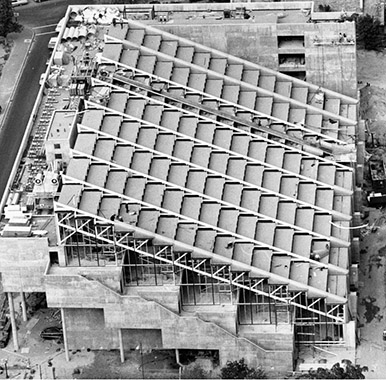
John Andrews, the architect of Gund Hall, affirmed this importance through his design—the Trays were not part of his brief for the building’s design and are solely his invention. The Trays serve as the backbone of the building. They also define its distinctive form. The physical structure of the building is also the symbolic foundation of the School. In a sense, Gund Hall is a language and a tool: a visual identity expressed in the built environment.
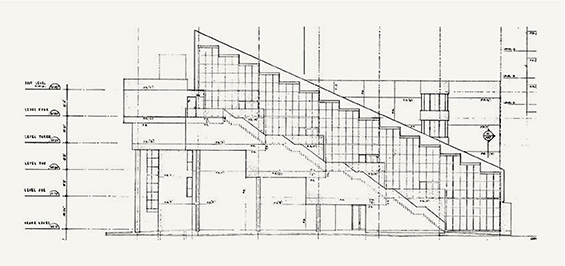
The Structural H
We took inspiration from Gund to develop the new GSD logo. The letter “H” immediately connects the GSD with Harvard. If we strip away the surface of the glyph, we reveal the underlying structure of the letter’s form and composition: its architecture. The letterform foregrounds the features of its own design and construction, just as Gund Hall does. The visual form, derived from self-reflexive inquiry, both embodies and represents the GSD’s pedagogical mission.
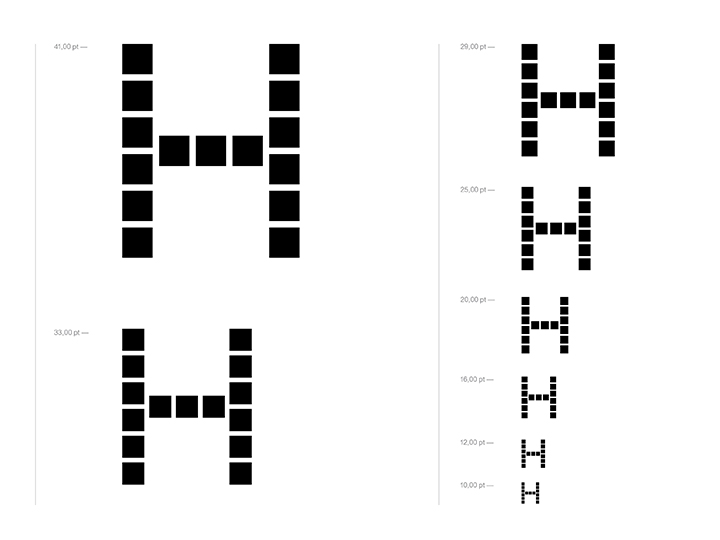
A Multiplicity of H’s
An institutional identity grows and changes over time. The GSD encompasses the multifaceted work that happens at Gund Hall. But the institution is bigger than a building. It is the network of people who put in the work—organizing, teaching, studying, building, communicating, and ultimately fashioning the School in their own unique ways. To be true to the GSD, the structure of the logo needs to accommodate a myriad of creative perspectives. A template of the “H” structure is available to students, faculty, and staff who are empowered to create their own versions of the wordmark.
Typeface
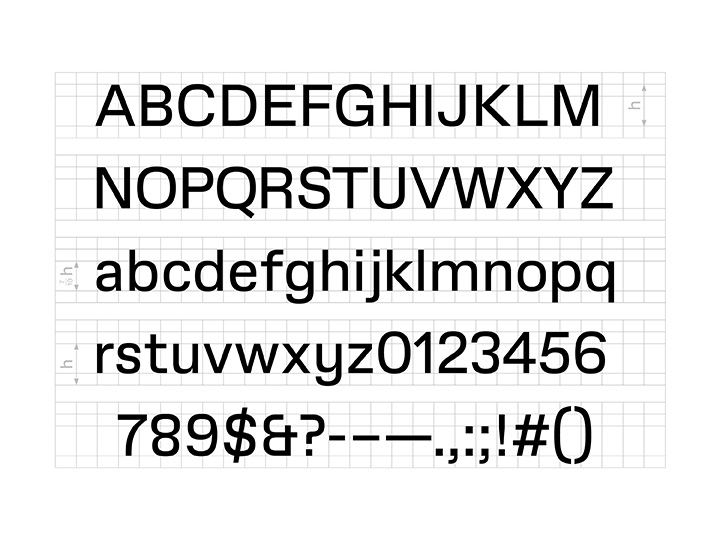
GSD Gothic is both an aesthetic companion to our new logo and a unique means of addressing a wide audience. It needs to be legible in different environments, from signage that feels at home in Gund Hall to dense documents circulating in print or online. It is the workhorse of the identity.

Variable Font for the Digital World
The typeface will exist in two different formats. A traditional format has different weights and styles—that is, regular, italic, bold. GSD Gothic will also exist in a variable format, an approach to typography suited to the digital world.

A variable format does not have discrete styles; it can exist in any variable between a set of parameters. This version of the typeface is delivered not in files but in code. It can live on our website and within other digital assets, and it can be programmed to react to dynamic conditions of display.
A System
The logo and wordmark function as separate elements, each addressing different needs.


But sometimes they come together. The different elements of this system will be displayed throughout the GSD, online, and in the documents that GSD community members use to correspond with the world.

The Harvard Graduate School of Design embarked on its new visual identity in 2022. It was officially adopted in fall of 2022, and since then has been implemented in phases. The GSD’s art director, Chad Kloepfer, designed the new identity.
Welcoming 2023–2024 Pollman Fellow Tosin Fateye

The Harvard Graduate School of Design (GSD) is pleased to welcome Tosin B. Fateye as the Pollman Fellow in Real Estate and Urban Development for the 2023–2024 academic year.
Fateye is a lecturer at the Redeemer’s University, Ede, Osun State, Nigeria. Having completed his Doctor of Philosophy (PhD) in Estate Management (Real Estate Investment and Finance option) at the Obafemi Awolowo University, Ile-Ife, Osun State, Nigeria, he holds BSc and MSc degrees in Estate Management at the same University. He teaches and carries out research in the areas of real estate investment appraisal, property development and finance, and sustainable real estate. Fateye is an International Real Estate Business School (IREBS) Foundation Scholar, a corporate member of the Nigerian Institution of Estate Surveyors and Valuers (ANIVS), a member of the African Real Estate Society (AfRES), and a Registered Estate Surveyor and Valuer (RSV). Fateye’s writings have been published in real estate trade journals, and two of his conference papers have won IREBS/AfRES Best Paper Award in the Real Estate Investment and Finance, and Valuation categories in 2018 and 2021 respectively.
Fateye’s research focuses on real estate investment performance measurement using econometric models. While his previous works focused on assessing property investment performance using underlying market fundamental and technical analyses, he is interested in exploring the behavioral finance approach to evaluate real estate pricing dynamics for comprehensive and optimal investment decision-making.
One of the fellowships and prizes administered by the GSD’s Department of Urban Planning and Design, the Pollman Fellowship was established in 2002 through a gift from Harold A. Pollman. It is awarded annually to an outstanding postdoctoral graduate in real estate, urban planning, and development who spends one year in residence at the GSD as a visiting scholar.



